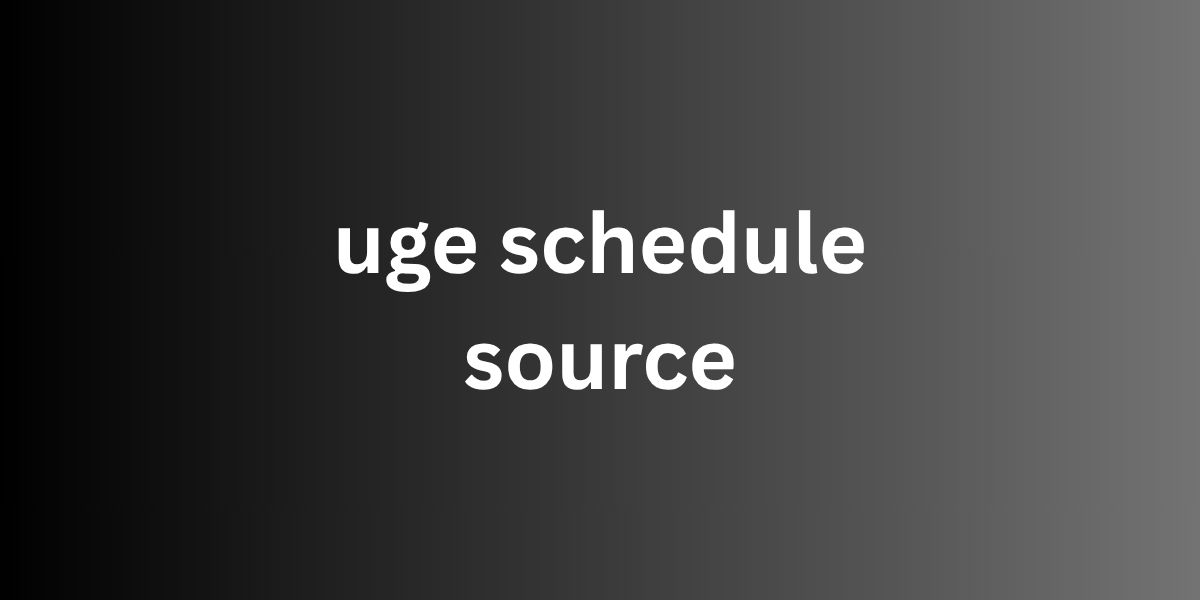The phrase uge schedule source might sound niche at first, but it holds significance for anyone involved in research, data operations, project management, or systems where schedules and all upstream governance environments (UGE) are central. Essentially, an uge schedule source refers to the authoritative system or repository that provides scheduling data and governance controls upstream—whether that’s managing batch jobs, orchestrating tasks, or integrating with larger operational workflows. It serves as the golden source where all downstream systems rely on consistent timing, dependencies, and triggers. Without a reliable schedule source, organizations risk cascading failures, misalignment across teams, and operational chaos.
Origins and Evolution of the uge schedule source
Historically, scheduling systems emerged to automate repetitive tasks and control workflows. Early tools like cron jobs, job schedulers, and batch processing platforms formed the backbone of operations. Over time, as systems grew complex and interconnected, the notion of a centralized governance-driven scheduler gained prominence. Today, the uge schedule source often encompasses advanced orchestration tools—think Jenkins pipelines, Kubernetes CronJobs, enterprise schedulers like Control-M or Autosys, and even cloud-based orchestration like AWS Step Functions. These modern sources offer an authoritative, traceable, and auditable path for scheduling, with role-based access, retries, failure policies, and integrated monitoring, addressing the needs of diverse enterprise environments.
Key Components of a Robust uge schedule source
A solid uge schedule source typically includes:
- A centralized dashboard or UI that presents schedules, job dependencies, and execution history in a unified view.
- Version control and audit logs so schedule definitions can be tracked, rolled back, and reviewed.
- Dependency management, allowing jobs to trigger after upstream tasks complete or based on external events.
- Retry and failure policies that define how to recover from failures—whether to retry automatically, alert, or escalate.
- Notifications and alerts, integrating with email, Slack, or incident management tools when jobs fail or exceed thresholds.
- Scalability and redundancy, ensuring the schedule source remains highly available and resilient under load.
Every piece supports the central promise of the uge schedule source: delivering consistent, reliable, and traceable scheduling across distributed systems.
Benefits of Having a Single uge schedule source
Centralizing scheduling into a single uge schedule source brings multiple advantages. First, it eliminates confusion—teams no longer wonder if their deployments are in sync or if different systems have diverging job timings. Second, it boosts reliability, since failures and their impacts are contained and managed through standardized policies. Third, it enhances security and compliance: audit trails and role-based controls allow organizations to prove who modified schedule definitions or when. Fourth, it simplifies observability: monitoring, log aggregation, and dashboards collectively show the full picture of pipeline execution. Finally, it empowers automation and scaling, because consistent definitions can be reused, templated, and provisioned across environments seamlessly.
Implementing a uge schedule source: Best Practices
When aiming to implement or improve your uge schedule source, consider these best practices:
- Audit current scheduling landscape by mapping all existing cron jobs, pipeline triggers, and manual processes. Understand overlaps, conflicts, and redundancies.
- Choose the right tool—based on your ecosystem, whether cloud-native (AWS, GCP, Azure), platform-based (Airflow, Control-M), or custom-built, ensure it supports your dependency, alerting, and auditing needs.
- Define ownership and permissions clearly. Who can create schedules? Who must review changes? What approvals are required before pushing into production?
- Migrate gradually. Start by onboarding low-risk, high-value schedules. Validate that execution matches expectations and build confidence incrementally.
- Automate deployment of schedule definitions using code, version control, and CI/CD pipelines.
- Monitor relentlessly. Use dashboards, alerting rules, and SLA tracking to detect and resolve issues quickly.
- Document thoroughly, including naming conventions, schedule governance policies, and contingency procedures.
By following these steps, your uge schedule source won’t just be another tool—it becomes the backbone of your orchestration strategy.
Real-World Use Cases of uge schedule source
In data engineering, teams rely on uge schedule sources to orchestrate ETL pipelines. Upstream ingestion jobs trigger transforms, loads, and analysis, all controlled from a centralized scheduling system. In DevOps, continuous integration and deployment pipelines hinge on well-coordinated job runs, using a trusted schedule source to ensure consistency across environments. In financial services, trade settlements, backup jobs, and reporting must align precisely—any drift can cause operational or regulatory breaches. Manufacturing and IoT systems also depend on predictive triggers—maintenance, data ingestion, and alerts—all governed by an authoritative scheduling engine. In every scenario, the uge schedule source helps maintain order, control, and chain-of-custody across automated workflows.
Challenges and Pitfalls to Watch
While powerful, a uge schedule source introduces complexity and potential pitfalls. Over centralization can lead to bottlenecks, especially if the tool isn’t performant or experiences downtime. Misconfiguration of dependencies could create cascading failures—one failed upstream job halts an entire chain. Poor access controls risk unauthorized schedule changes. Lack of documentation or inconsistent naming conventions may cause confusion among teams. Alert fatigue can lead to missed issues if too many trivial failures flood channels. To mitigate these, always ensure scalability, fault tolerance, disciplined governance, clear naming patterns, and prioritized, actionable alerts.
Looking Ahead: The Future of uge schedule source
As enterprises embrace microservices, containerization, and event-driven architectures, the uge schedule source will evolve. We’re seeing increased blending between scheduling tools and service meshes, dynamic event triggers, and intelligent orchestration that adapts to system load or anomalies. Expect AI-powered scheduling advisors that recommend optimal runtimes, conflict avoidance, or even self-healing pipelines. Cloud providers are embedding richer scheduling features directly into serverless and platform services, reducing friction. The uge schedule source of tomorrow will be more predictive, resilient, and autonomous—yet still centralized enough to offer governance, traceability, and auditability.
Frequently Asked Questions (FAQs)
What exactly counts as a “source” in “uge schedule source”?
A uge schedule source refers to the definitive system or repository that issues scheduling instructions upstream—whether that’s a job scheduler, pipeline orchestrator, or cloud workflow engine. It’s where schedules are authored, audited, and executed.
Should every team use the same uge schedule source, or can there be multiple?
Ideally, there’s a single authoritative uge schedule source for consistency and governance. In practice, large organizations may adopt multiple tools per domain—but they should integrate or federate via a common layer to preserve traceability and reliability.
How do we migrate existing cron jobs into a uge schedule source?
Start by inventorying current cron entries, prioritizing critical or failure-prone jobs. Migrate them incrementally—monitor the new setup’s behavior, compare metrics, then gradually shift teams over, preserving audit trails and enabling rollback.
What are signs that our uge schedule source is failing or risky?
Look for frequent upstream job failures without clear owner, cascading stoppages across pipelines, missing audit logs, uncontrolled changes in timing, or recurring alert fatigue. These signal gaps in governance or resilience.
Will cloud platforms eventually eliminate the need for a separate uge schedule source?
Cloud platforms are embedding smarter scheduling directly in their services, but for complex, multi-team, or regulated environments, a centralized authoritative schedule system still offers unmatched governance, auditability, and orchestration capabilities.
For More Visit celeb today
Disclaimer: The information provided in “Understanding the UGE Schedule Source: What It Is and Why It Matters” is for general informational purposes only. It does not constitute professional, technical, or legal advice. While every effort has been made to ensure accuracy at the time of publication, schedules, requirements, and related details may change without notice. Readers should verify information through official UGE documentation or authorized representatives before making decisions based on this content. The author and publisher are not responsible for any losses, errors, or consequences arising from reliance on this material.










